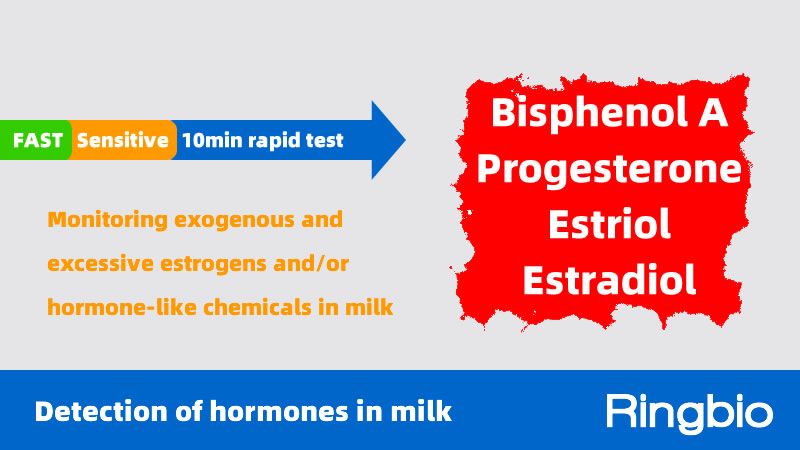Basic information on estrogen, progesterone and bisphenol A
Estrogen mainly presents in females and is responsible for important physiological development. Generally, estrogen levels impact the physiological functions of humans. A low level of estrogen content may increase the risk of chronic diseases, while a high level of estrogen exposure can also damage the health of the individual. Consequently, exogenous estrogen in milk will have these side effects on humans, thus it is strictly controlled. Commonly known estrogen includes estriol, estradiol, etc.
Progesterone is a hormone produced by the cow during ovulation and can be detected from samples of milk. Progesterone rises and falls during different periods of the cow's reproductive cycle. A typical cycle is around 21 days in duration.
Bisphenol A is used as plastic additives, lacquers, resins, or surfactants and can be found in milk due to contact with plastic materials during food processing and storage.
Endogenous and exogenous estrogen and progesterone
Since estrogen is present in cows, so normal milk will contain these substances at certain concentrations. According to a review by Hassan MALEKINEJAD[1], the concentration of estriol in cow milk is 0.027 ± 0.01 ng/ml, and the concentration of estradiol is 0.02 ng/ml, the concentration of progesterone in milk is 9.81 ng/ml. In another research done by D.A.Pape-Zambito[2] showed that estradiol concentration varies from 0.4 - 6.0 pg/ml.
All research indicated that endogenous estrogen exists but was all detected at very low levels (less than 1ng/ml). For progesterone, the concentration depends on the physiological cycle of the cow.
Monitoring estrogen and progesterone contamination in milk with rapid test kits
The conventional method for monitoring estrogen and progesterone is HPLC, LC-MS/MS, etc., which is time-consuming and high-cost. Thus the detection of these chemicals can only be carried out in certain labs such as testing centers of big companies or third-party labs. In order to meet the regulatory requirement, small manufacturers such as food factories, plastic factories, etc shall also perform the related testing.
Currently, Ringbio has provided the following test kits for monitoring estrogen and progesterone contamination in milk based on the competitive lateral immunoassay in which specific monoclonal antibodies against these chemicals are used to capture the related contamination in samples, which can then produce a highly specific and accurate result. The detection limit meets the regulation requirement. These tests can be applied to milk and milk products.
| Item # | Description | Detection Limit (ug/L, ug/kg, ppb) |
| 100058 | Estriol Rapid Test Kit | 5 - 8 |
| 100055 | Estradiol Rapid Test Kit | 5 - 8 |
| 102205 | Progesterone Rapid Test Kit | 6 - 8 |
| 102005 | Bisphenol A Rapid Test Kit | 6 - 8 |
If you are interested in any of these tests for monitoring estrogen and progesterone contamination in milk, please feel free to contact us by email to [email protected].
Reference
- Malekinejad, Hassan, and Aysa Rezabakhsh. “Hormones in Dairy Foods and Their Impact on Public Health - A Narrative Review Article.” Iranian journal of public health vol. 44,6 (2015): 742-58.
- Pape-Zambito, D. A., Robert F. Roberts, and R. S. Kensinger. "Estrone and 17β-estradiol concentrations in pasteurized-homogenized milk and commercial dairy products." Journal of dairy science 93.6 (2010): 2533-2540.




